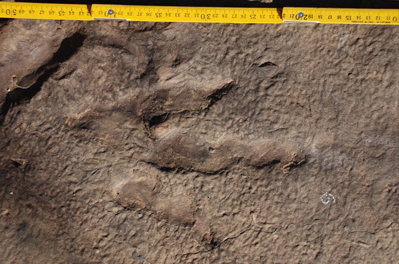Researchers re-analyzed a fossilized tracksite in southern Africa that was originally discovered more than 40 years ago, and were able to discern how early dinosaurs made on-the-fly adjustments to their movements to cope with slippery and sloping terrain. This analysis also provides insight into later evolution of the group.
The research was conducted by researchers at the University of Michigan, Argentina’s Universidad de Buenos Aires and the Iziko South African Museum in Cape Town, South Africa at the Moyeni tracksite in Lesotho. More than 250 footprints exist there, dating from the beginning of the Jurassic Period about 200 million years ago.
According to the University of Michigan press release:
When they analyzed the tracks, the researchers determined that ornithischians changed their way of walking as surface conditions changed. In the river bed, they crouched low, adopted a sprawling four-legged stance, and crept along flat-footed, dragging their feet. On the slope, they narrowed their stance, still walking on all fours, but picking up their feet. Once they reached the flat, stable ground on top, they switched to walking on two legs.
In contrast, the theropod that crossed the surface didn’t vary its posture or gait. Remaining upright on two legs, it used claws on its toes to grip slippery surfaces.
The use of gripping claws by the theropods also suggest the possibility of the later evolution into birds.
To read more about the details of the study, and to view a slideshow of some of the incredible photos and infographics presented, check out the press release and the PLoS ONE journal article.

